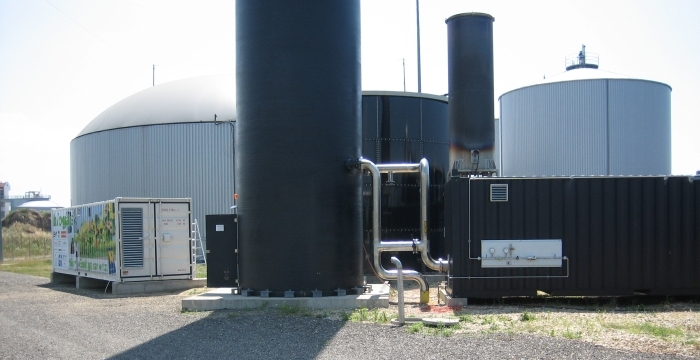Membrane Biogas Upgrading
Biogas is a combustible gas, which is produced by fermentation of biomass of any kind. The starting materials are primarily fermentable biogenic materials, such as sewage sludge, organic waste or food waste, manure (slurry, manure), not previously used plants and plant parts (such as cover crops, crop residues, and the like), as well as specially cultivated energy plants (renewable raw materials). Biogas is produced by the microbial degradation of organic matter under anaerobic conditions.
There are two key processes: mesophilic and thermophilic digestion.
| Parameter | Unit | Raw biogas (typical values) |
Gas quality for grid injection according ÖVGW G31/G33 |
Gas quality for fuel purposes according BGBL 417-II 2004 |
|---|---|---|---|---|
| Upper heating value | [kWh/m³STP] | 6,0 to 9,3 | 10,7 to 12,8 | 8,4 to 13,1 |
| Wobbe-index | [kWh/m³STP] | 6,0 to 11,1 | 13,3 to 15,7 | 12,1 to 15,7 |
| Relative density | [-] | 0,70 to 1,20 | 0,55 to 0,65 | 0,55 to 0,70 |
| Methane content | [mol%] | 40 to 80 | ≥ 97,0 (absence H2) * | ≥ 89,5 (absence H2) * |
| Carbon dioxide content | [mol%] | 14 to 55 | ≤ 2,0 | unspecified |
| Ammonia content | [mg/m³STP] | ≤ 1.000 | technically free | unspecified |
| Hydrogen sulphide content | [mg/m³STP] | ≤ 2.000 | ≤ 5,0 | unspecified |
| Oxygen content | [mol%] | ≤ 2,0 | ≤ 0,5 | unspecified |
| Nitrogen content | [mol%] | ≤ 20,0 | ≤ 5,0 | unspecified |
| Water content (dewpoint) | [°C] | < 37 @ 1 bar | ≤ -8 @ 40 bar | unspecified |
*...not directly specified, but calculated from other specified parameters (upper heating value or Wobbe-index)
Biogas can be used for electricity production in a CHP gas engine, or biogas can be concentrated in a biogas upgrader to the same standards as fossil natural gas, injected into the natural gas grid or used as a vehicle fuel (CNG). If injected into the natural gas grid, the upgraded biogas (often referred as biomethane) is obliged to fulfill the quality criteria defined by the relevant laws, e.g. the ÖVGW G31 and G33 in Austria. If used as a fuel for CNG-vehicles, different regulations come into action, e.g. the Austrian BGBL 417-II 2004.
In order to fulfill the obliged quality criteria, the biogas has to be cleaned from malicious substances like hydrogen sulphide or ammonia, it has to be dried and the main contaminant carbon dioxide has to be removed. Thus, the heating value of the biogas is significantly increased and the Wobbe-index is adjusted so that the combustion behavior of the produced biomethane is similar to the one of fossil natural gas. As a result, the biomethane can be used as a carbon-dioxide-neutral biogenous substitute of the fossil natural gas.
Commonly used biogas upgrading processes:
- PSA systems
- Water scrubbers
- Amine scrubbers
- Membrane systems
axiom with his twenty years experience in membrane technology, entered this business 2001 with first trials in biogas upgrading together with Vienna University of Technology. After continuous research, optimisation and process improvement performed by these two partner organisations, membrane-based biogas upgrading nowadays is commercially available state-of-the-art. It has proven to be a stable, economic and competitive process alternative.

Figure: The first industrial-scale biogas upgrading plant in Austria in Bruck/Leitha: Membrane separation technology supplied by axiom